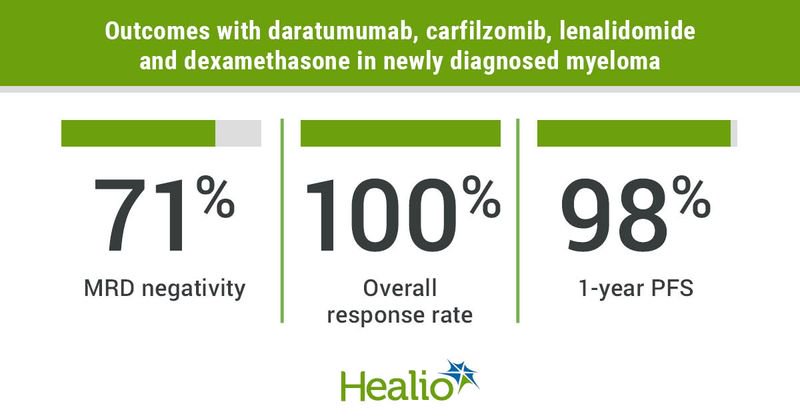Daratumumab regimen safe, effective in newly diagnosed multiple myeloma
The combination of daratumumab, carfilzomib, lenalidomide and dexamethasone conferred high rates of minimal residual disease negativity among patients with newly diagnosed multiple myeloma, according to phase 2 study results.
Researchers observed no new toxicities with the daratumumab (Darzalex, Janssen) combination compared with standard-of-care carfilzomib (Kyprolis, Amgen), lenalidomide (Revlimid, Celgene) and dexamethasone.

“Daratumumab has been safely added to several combination therapies and shown added clinical benefit. Until the current study was conducted, all prior four-drug combination therapy studies also included high-dose melphalan chemotherapy followed by autologous stem cell transplant [HDM-ASCT],” C. Ola Landgren, MD, PhD, professor of medicine, chief of the myeloma program in the division of hematology and leader of the experimental therapeutics program at Sylvester Comprehensive Cancer Center at University of Miami, told Healio. “We wanted to design the first study to determine the rate of minimal residual disease [MRD] negativity using an effective and modern four-drug combination, without the influence of HDM-ASCT.”

The nonrandomized MANHATTAN trial sought to determine whether the addition of daratumumab — a CD38-targeting human immunoglobulin G kappa monoclonal antibody — to weekly dosing of the proteasome inhibitor carfilzomib plus lenalidomide and dexamethasone (wKRd-D) without HDM-ASCT was associated with high rates of MRD negativity. Researchers also aimed to establish the safety profile of the four-drug combination.
The study enrolled 41 patients with newly diagnosed multiple myeloma (median age, 59 years; 61% women; 49% with high-risk disease) between Oct. 1, 2018, and Nov. 15, 2019, at Memorial Sloan Kettering Cancer Center. Treatment consisted of eight, 28-day cycles of 16 mg/kg IV daratumumab on days 1, 8, 15 and 22 of cycles one and two, days 1 and 15 of cycles three to six, and day 1 of cycles seven and eight; 20/56 mg/m² IV carfilzomib on days 1, 8 and 15; 25 mg oral lenalidomide on days 1 to 21; and 40 mg oral or IV dexamethasone weekly during cycles one through four and 20 mg after cycle four.
A 40% or higher MRD-negativity rate with wKRd-D served as the primary endpoint. Secondary endpoints included safety and tolerability, rates of clinical response per the International Myeloma Working Group, and estimated PFS and OS rates.
Median follow-up was 20.3 months (95% CI, 19.2-21.9).
The study met its primary endpoint, with 29 patients (71%; 95% CI, 54-83) achieving MRD negativity. Median time to MRD negativity was six (range, 1-8) cycles of treatment.
One patient with MRD negativity progressed 9 months later but maintained a complete response in the peripheral blood without clinical symptom onset and continued on unchanged maintenance therapy.
Additionally, among eight patients assessed for MRD at 1 year, 88% showed sustained MRD negativity.
The overall response rate was 100%, and nearly all patients (95%) had a very good partial response or complete response to therapy.
Researchers reported estimated 1-year rates of 98% (95% CI, 93-100) for PFS and 100% for OS.
Common grade 3 or grade 4 adverse events included neutropenia (27%), rash (9%), lung infection (7%) and increased alanine aminotransferase level (4%). No patient deaths occurred.
“In the MANHATTAN study, we used an effective and modern four-drug combination therapy and found the rate of MRD negativity to be 71% after up to eight cycles of weekly treatment, without HDM-ASCT. This represents a new era of treatment for newly diagnosed [patients with multiple myeloma],” Landgren said. “There were no new toxicities compared with standard-of-care carfilzomib, lenalidomide and dexamethasone. Using optimized IV fluid management and modern anticoagulation prophylaxis, we found this regimen overall to be safe and highly effective.”
Limitations of the study included its single-center, nonrandomized phase 2 design.
“We have launched a large, randomized study as a follow-up to the current trial,” Landgren said. “The ADVANCE study is a multicenter study examining the use of weekly daratumumab plus carfilzomib, lenalidomide and dexamethasone compared with standard of care. The study is open for enrollment.”
For more information:
C. Ola Landgren, MD, PhD, can be reached at University of Miami, 1120 NW 14th St., Clinical Research Bldg., Room 650D, Miami, FL 33136; email: col15@miami.edu.


